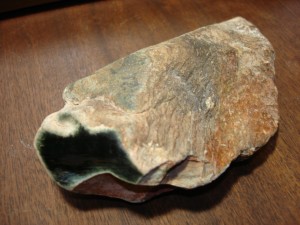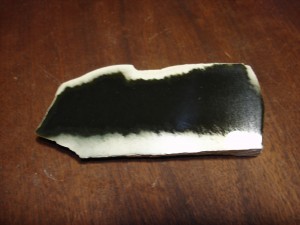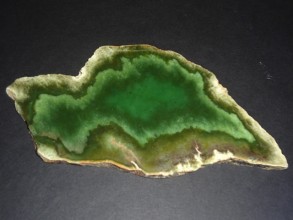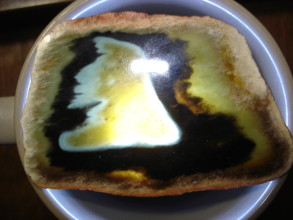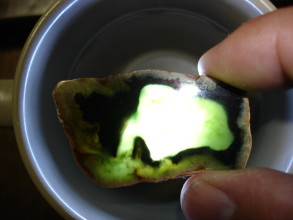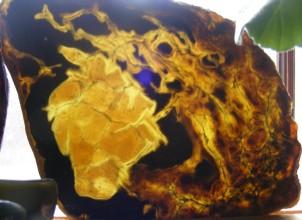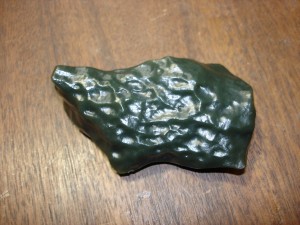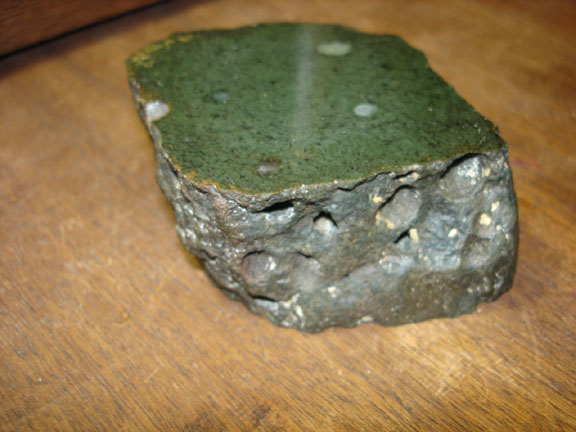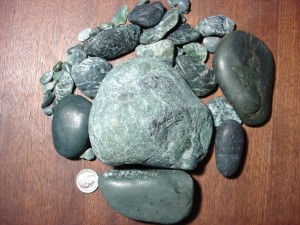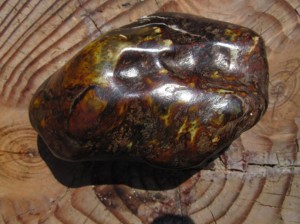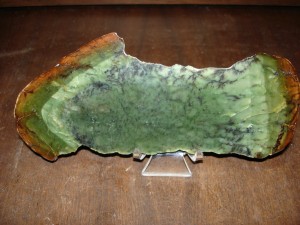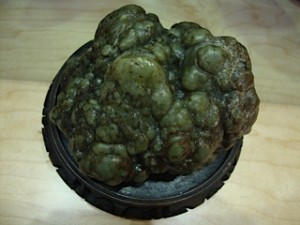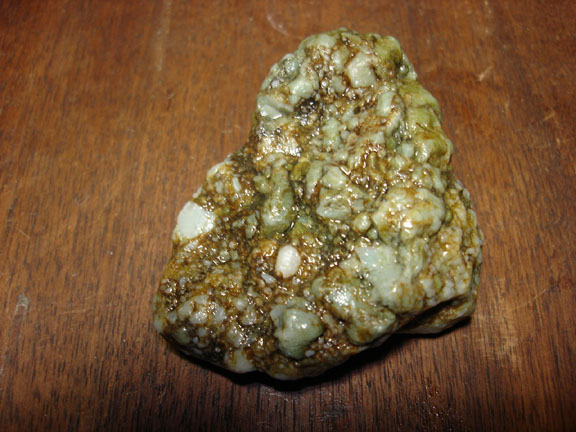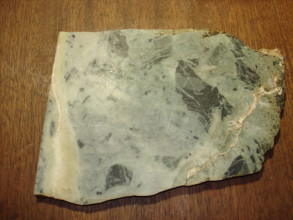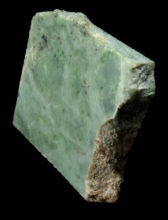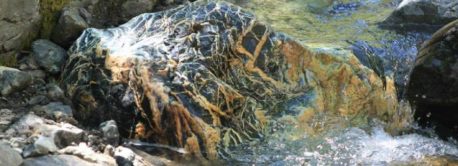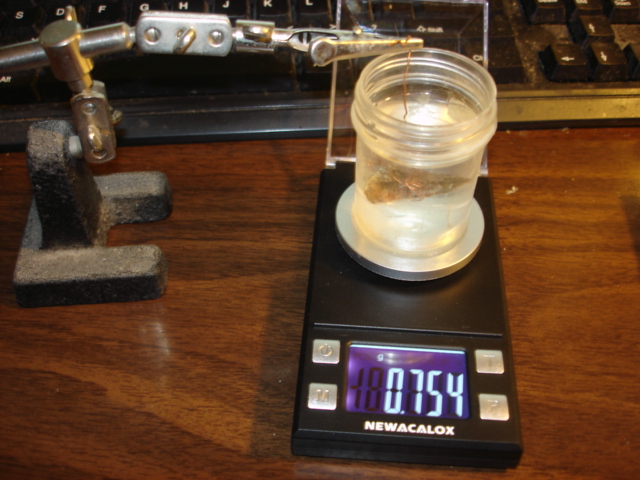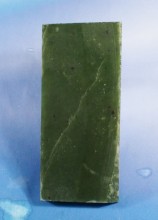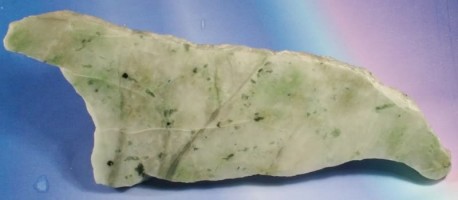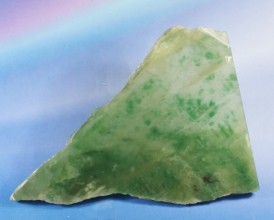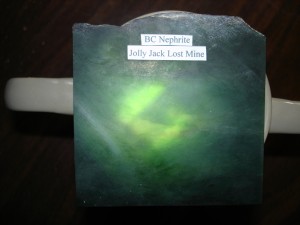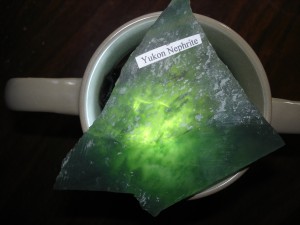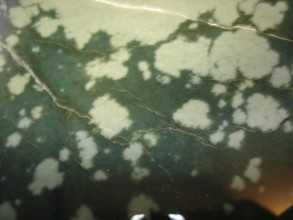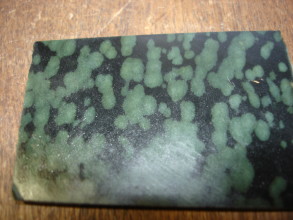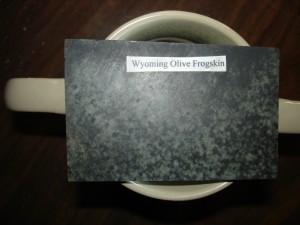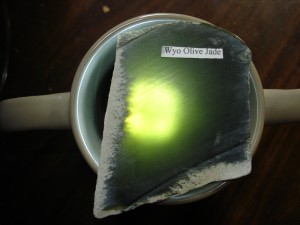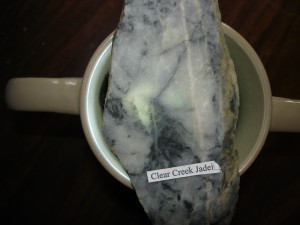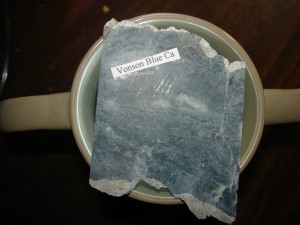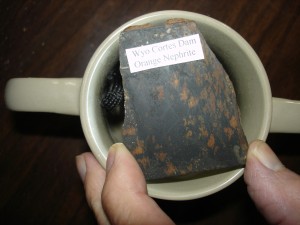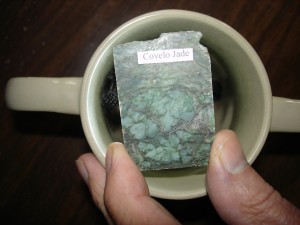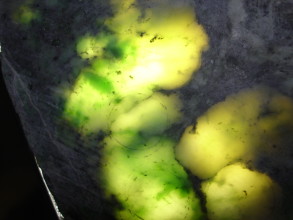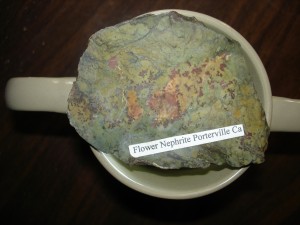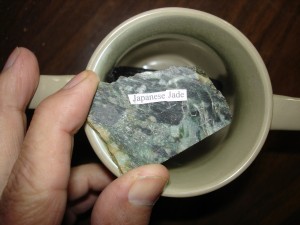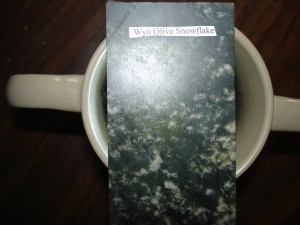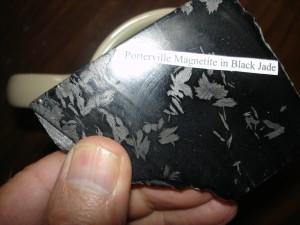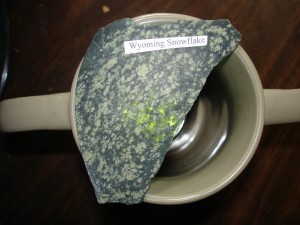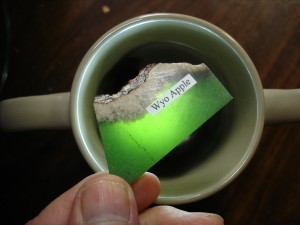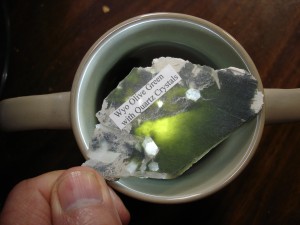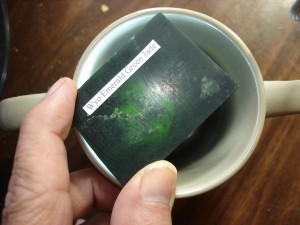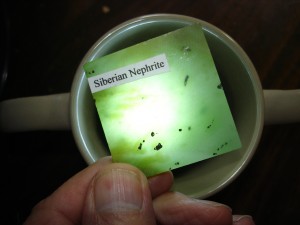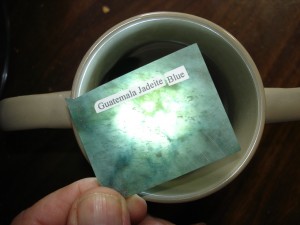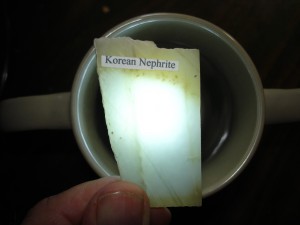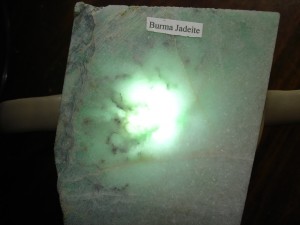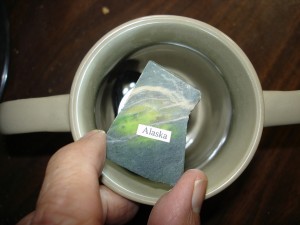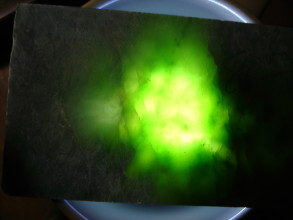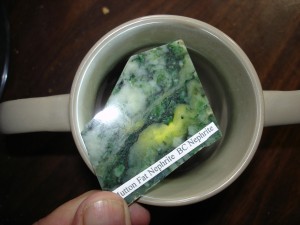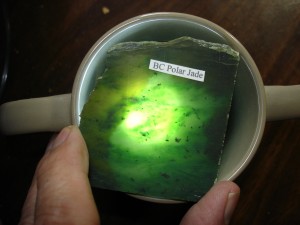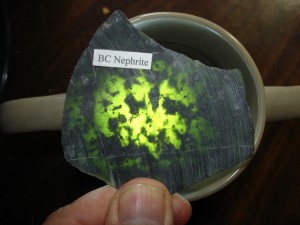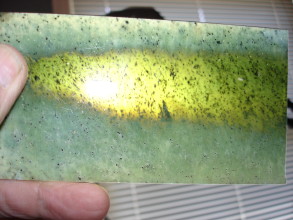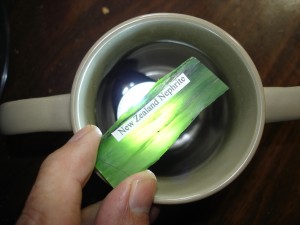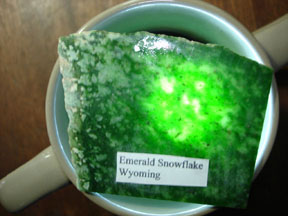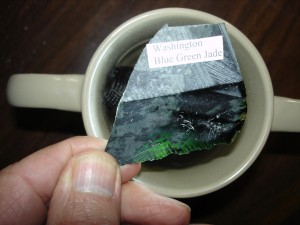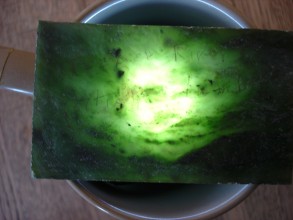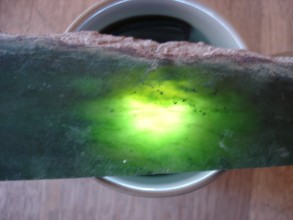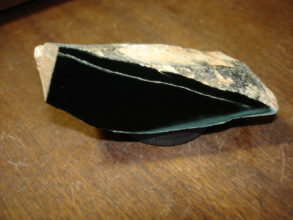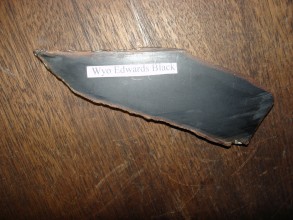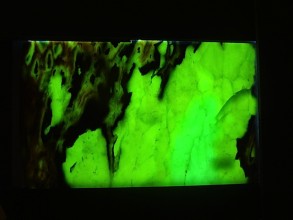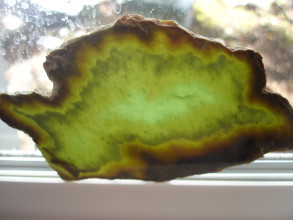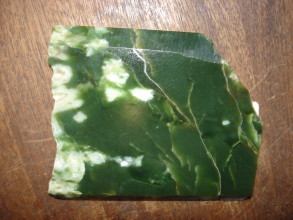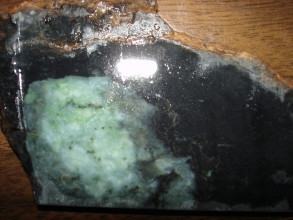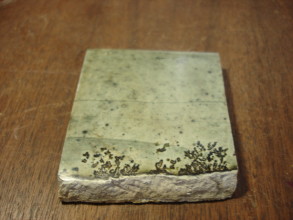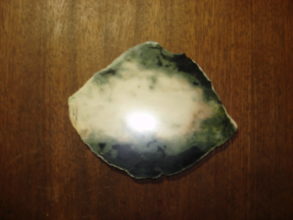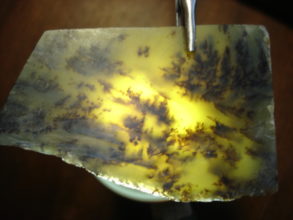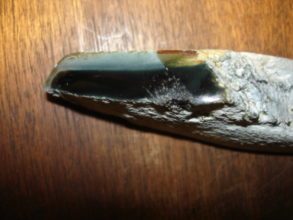Category Archives: Jade Types -Reference
Jade Ways Illustrated
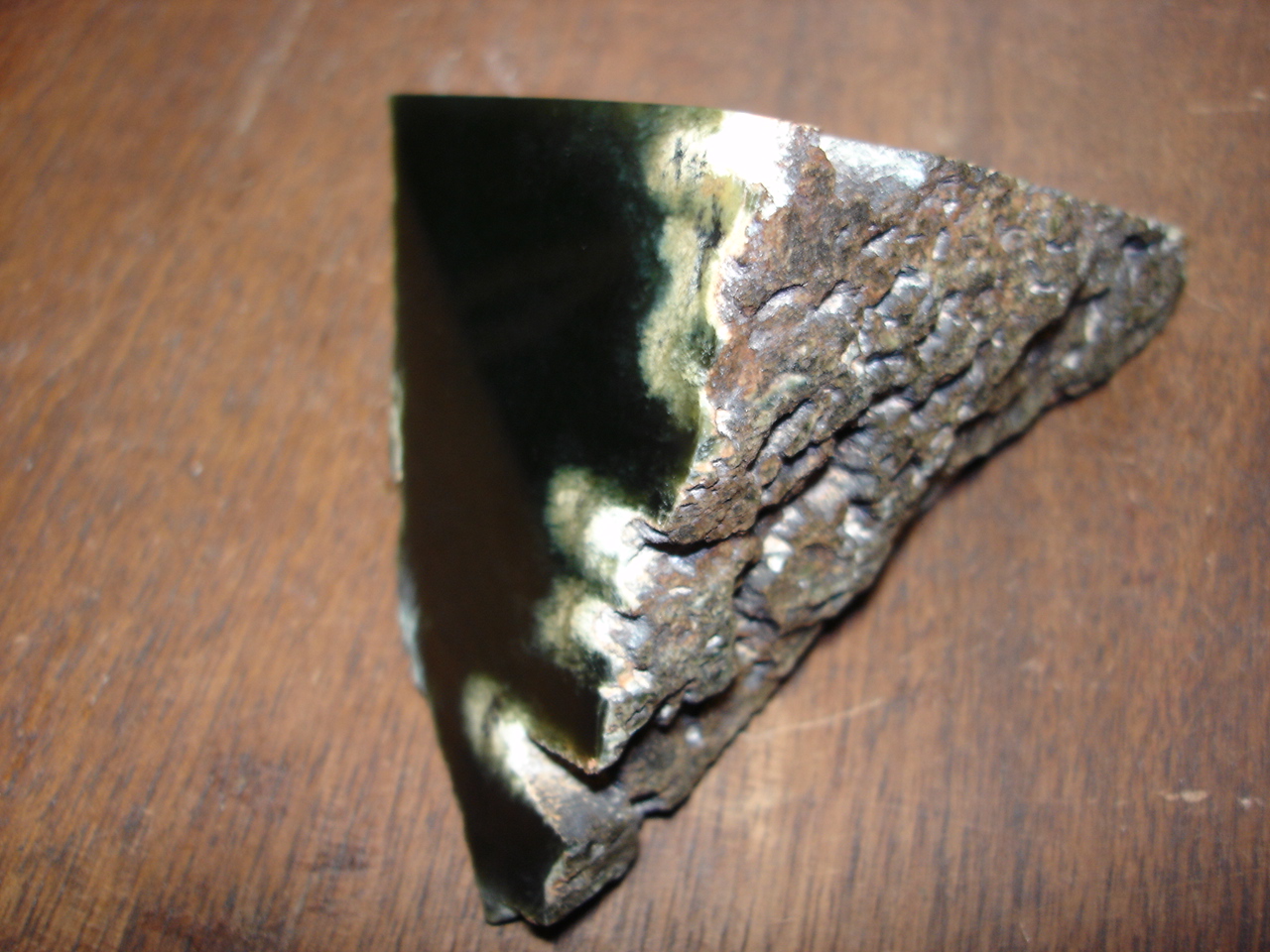
BY JAY E. BATES
WYOMING JADE
Out on the Wyoming plains lies a weather worn piece of “cinder jade” deeply etched by cold dry driven ice and sand and rock numbing cold. Yet under the rough brown blackened deep-pitted rind lies a beauty of unimagined luminosity and enduring radiance, cold to the touch as if forever marked by the eons of driven snow and cold. The green luminosity belies an inner toughness of no other comparable stone. The toughness is interwoven into the very fiber beaten upon earth’s anvil of tectonic forces, then through erosion, exposed to the surface to endure one of the harshest climates on the planet. Thus is produced one of the finest known nephrites, treasured by many and admired by more than a few.
The formation of Wyoming nephrite has been best described by the Wyoming Geological Society as follows:
“Nephrite, a product of metasomatism and alteration, occurs as sheets, lenses, and nodules along or near contacts between dissimilar rock types in strongly metamorphosed zones (Sinkankas, 1959). It also occurs in or adjacent to faults and fault zones. Nephrite in Wyoming is found within granitic gneisses and granites where enclosing or intruding amphibolites have been altered. Sherer (1969) investigated nephrite jade in Wyoming and suggested that it developed from metasomatic alteration of amphibole during metamorphism. Disrupted blocks of amphibolite became trapped as xenoliths in quartzofeldspathic gneiss, and were subsequently altered to nephrite by fluids derived from regional amphibolite-grade metamorphism. Amphibole, primarily hornblende, reacted with hot metamorphic fluids to produce actinolite (nephrite jade), clinozoisite, and chlorite. In the Laramie Range, this alteration was concentrated along shear zones and fractures where it resulted from the emplacement of quartz diorite, vein quartz, or pegmatite. Water loss at sites of nephrite development stopped the alteration process that otherwise would have eventually converted nephrite into serpentine. Wallrock alteration accompanied nephrite development, bleaching leucocratic granite-gneiss adjacent to the jade to produce a mottled pink and white granite-gneiss halo with associated secondary clinozoisite, pink zoisite, epidote, chlorite, and white plagioclase pervasively altered to mica (Hausel and Sutherland, 2000).”
Double click twice photographs to super-size to see details:
BELOW: Wyoming Jade Rind
BELOW: Wyoming Jade with White Rind
BELOW: Wyoming Bull Canyon Patterned Nephrite
Once formed, nephrite jade is much more resistant to erosion than its enclosing rocks, and is often found in residual and alluvial deposits as rounded boulders and cobbles. Alluvial jade tends to be solid, flaws and weak or impure zones having been removed during erosional processes. Because of nephrite’s durability, cobbles and boulders often survive transport over great distances from their source. They may also take on a natural polish from fluvial abrasion and from wind-driven sand in desert areas such as the Granite Mountains. Naturally polished pieces of nephrite jade exhibit a high-gloss, waxy surface and are known as jade slicks (Hausel and Sutherland, 2000). When not in the form of slicks, nephrite pieces may be covered with a cream to reddish brown oxidized weathering rind that hides the jade’s true color. Experienced jade prospectors learn to recognize this weathered surface, and can often recognize jade that others have overlooked.”
BELOW, LEFT: Wyoming Jade Slick
Sometimes the relentless driving Wyoming wind and sand, cold and hot freezing and thawing cycles, can carve out the less durable inclusions in the nephrite such as quartz crystals. Wyoming nephrite is the only jade that I am aware that often has quartz crystals included. Below is a quartz crystal included piece of Wyoming Cinder Jade where the wind and sand and extreme temperatures has eroded out the quartz crystals leaving cinder jade:
BELOW: Wyoming Cinder Nephrite (Also see Featured Jade at top of post)
The white spots on the sawn and polished surface of the nephrite are the tops of quartz crystals.
The 1930s and 1940s were the “glory days” of jade hunting in Wyoming. Many sources cite 1936 as the year of nephrite discovery near Lander, most likely by sheep herders. From 1936 until 1945, nephrite hunting was principally done by Wyoming residents as tough as the jade they sought. The end of World War II plus a 1945 article in Popular Science titled “Green Gold of Wyoming” changed all that. Something akin to a gold rush was on in central Wyoming and competition for Wyoming jade became intense. Some 7,000 to 8,000 pounds of jade were collected during the summer of 1945 alone. The link to gold was not unfounded. Famed Wyoming jade hunter Allan Branham once stated that “…jade lures and lures as no other stone. It is as bad as the gold fever, and once entangled with jade one seldom recovers.”

CALIFORNIA JADE
While a jade rush was on in Wyoming, things were pretty quiet in California, although some of the state’s mineral clubs were quietly collecting nephrite and jadeite throughout the state. One of the locations was Jade Cove and the adjacent coves near San Simeon on the Monterey Coast. Jade Cove was originally discovered by E. S. Parmalee of Palo Alto around 1941 and rediscovered by others in 1947 and henceforth was a well known destination of amateur mineral and lapidary societies of the state for jade collecting. During the 1960s and 1970s rockhounds and divers, and sometimes rockhounds who were also divers began diving and searching for nephrite at Jade Cove. One of those divers who was a record free diver and dove many times for jade at Jade Cove is Harry White who is well-known as The San Francisco Gem and Mineral Societies primary field trip leader and faceting instructor. Here is a youtube clip by Mike Burkleo discussing his involvement with jade and his diving for jade at Jade Cove California: https://www.youtube.com/watch?v=VFUKs4jA5co
The word was soon out about some of the fine nephrite being found and quite a few people were soon scramble and digging for jade all over the beaches and cliffs. When things got out of hand with winches and dynamite, rules were imposed to allow only digging within the tidal zone and restricted methods of removal from the ocean. Monterey jade comes in many shades including blue, but most are a dark green shading to black.
BELOW, Jade Cove Nephrite
Big Sur Vulcan jade is a favorite rare type of nephrite found near Jade Cove. This jade naturally erodes out of the ancient seabed having been thrust up about 200ft above sea level by colliding tectonic plates. This ancient seabed is loaded with serpentine and jade materials that have been sitting in the iron rich soil for millennia. Nephrite jade is very porous and iron rich waters “stains” the exterior the jade with vibrant orange, reds, yellows and browns shading into green towards the center, sometimes with dendrites of presumably manganese oxide.
BELOW: Vulcan Jade
BELOW: Vulcan Jade Slab (Note zones of staining)
Most of the nephrite and jadeite found in California comes from the coastal ranges and the metamorphic zones created by massive plate tectonics where the Pacific plate is being subducted below the North American plate. During this process, quite a bit of pressure and some heat can occur in the presence of super-hot mineral rich water. When conditions are right, the two types of jade may form, nephrite and jadeite.
Sometimes slow cooling grape-like structures are formed in the jade to create Botryoidal Jade which is highly prized by collectors for its visual appeal.
BELOW: Jade Cove Botryoidal Jade
Within San Benito County in the Clear Creek Area is found a jadeite. Usually a jadeite will exhibit a crystal structure within, and such a crystal structure is evident in most Clear Creek Jadeite. Clear Creek Jadeite is generally not as a fine of a quality as some of the jadeites found in Burma and Guatemala, although it was been reported that Clear Creek jadeite is purer than the jadeite from Burma.
BELOW: Clear Creek Jadeite
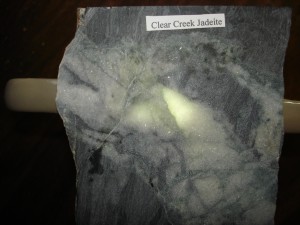
Jadeite along with nephrite has also found up near Covelo in Mendocino County, California. Over the years, the San Francisco Gem and Mineral Society and other clubs have had many field trips to the Covelo area to look for jade. Quite a number of nice pieces of nephrite and green and white diopsidic nephrite have been found, some of it botryoidal. Jadeite has been found in the past near Covelo by the California Division of Mines and Geology as described in their “Special Report 10-C (September 1951)”. However, I have had several pieces of jade from Covelo spectographically tested by Vic Showell of Washington and much of which was thought to be jadeite tested out as hydrogrossular garnet and vesuvianite. Some did test as diopsidic nephrite.
BELOW: Botryoidal Nephrite from Covelo
BELOW: Jadeite from near Covelo, specific gravity 3.25 Blands Peak Taliaferro Ridge east of Leech Lake
CALIFORNIA LOCATIONS FOR JADE
Occasionally jade, mostly nephrite has been reportedly found in the following California locations: 1. South fork of Indian Creek. 2. Clear Creek above Klamath River.. 3. Klamath River. 4. Trinity River. 5. North fork of Trinity River. 6. South fork of Trinity River. 7. Along surf-line of Pacific from Patricks Point to Dry Lagoon. 8. Van Dusen River . 9. Mad River. 10. North fork of Elder Creek. 11. Williams Creek. 12. North fork of Eel River. 13. Blue Banks on Estel Ridge. 14. Middle Fork of the Eel River. 15. Main Eel River. 16. Feliz Creek. 17. Russian River. 18. North fork of Cache Creek. 19. Big Stony Creek. 20. Big Stony Creek tributaries. 21. Hyphus Creek. 22. West branch of the North Fork of the Feather River. 23. Concow Lake watershed. 24. Feather River across from Pulgas. 25. Valley Ford. 26. Massa Hill 27. Angel Island. 28. Mt Diablo. 29 Stifle Memorial Claim. 30. American River. 31. Fly Away Gulch. 32. David Gulch. 33. Clear Creek. San Benito County. 34. Jade Cove Monterey County. 35. Cape San Martin. 36. Leffingwell Creek. 37. Salinas River. 38. Lewis Hill north of Porterville. 39. South slope of Figueroa Mt. near Los Olivos. 40. Mohave River near Victorville. 41. Eagle mts. outside Joshua Tree Nat. Mon.
Caution, many of the above locations are on private lands and parks and are not available for collecting. Caution is advised to anyone using this list to look for jade. For instance the jade supposedly found at Concow Lake is most likely basanite, a fine grained black basalt or jasper that will take a good polish.
Also if you do find something it may or may not be considered jade without at least testing for hardness and specific gravity. Without testing for at least hardness and specific gravity whatever you find should not be sold as jade.
GENERAL
Jade is a difficult gemstone to absolutely identify without expensive tests. Almost always it is found in known locations where it has been previously found. You can usually do a scratch test with a knife blade for nephrite. Nephrite has a hardness of 6.5. If it scratches with ordinary steel, it is not nephrite, probably serpentine; the exception being some of the Mariposa County nephrites that contain talc. Quartz or chalcedony will scratch nephrite. If quartz or chalcedony doesn’t scratch your potential nephrite, it is not nephrite. If it doesn’t scratch with an ordinary knife blade, but does scratch with a quartz crystal, it could be nephrite. Then you should test your potential nephrite for specific gravity.
Many times testing for specific gravity also helps to identify jade. Jadeite has a specific gravity of 3.34. Nephrite has a specific gravity of usually 2.95, (with a range between 2.90 and 3.02).
Specific gravity of a rock is the weight of a rock divided by the weight of water displaced by the rock. An easy way to get the specific gravity of a rock is to weigh it, then place a container of water with the wire to suspend the jade in the water on your scale and turn it on again so it is zeroed in, then reweigh your rock suspended in the water on the wire. I use a old cut down plastic film can as my container. Any thin wire or thread will do as you are only weighing the water displaced by the wire not the wire. I use a rather inexpensive scale (NEWACALOX) that will weigh up to 100 grams with an accuracy of .001 grams. Make sure the rock or wire does not touch the sides or bottom of the container and the rock is completely under water. Tap the suspending device to see if the weight measurement changes. If it does, your rock is touch the sides or bottom. Test using a small piece of known nephrite until you are comfortable with what you are doing and get the right reading. This methodology is quite useful when you can use a small piece of suspected jade to test for specific gravity without having to break apart a large visual specimen for testing.
Another method of testing for specific gravity is to use a fish weighing scale that weighs things hanging from the scale. I use a $20 “Fishfun” scale that weighs to 110 pounds with an accuracy of .005 pounds. Using this method, specific gravity is the weight of your rock / weight of the rock minus the weight you got of the rock suspended in a bucket of water from your fish weighing scale.
Here is a photograph of one of my tests for specific gravity, testing for jade.
There may be some jade somewhere that is magnetic, but if a magnet sticks to your rock, you can assume it is not jade. The magnetite in Stoddard Wells black nephrite is magnetic, but not the nephrite. It needs to be remembered that jade is a rock, not a mineral, and other minerals beyond the jade forming minerals can also be present. Often these other minerals contribute to the jades visual qualities and the uniqueness of the various recognized varieties of jade.
Nephrite will usually produce a milky white residue slurry when cut by a diamond saw or wheel. Nephrite will not fluoresce. Light green jadeite will show pale white under LW. Sometimes a weak green or yellow will appear.
For the last couple decades the best jade, mostly nephrite such as Polar and Ogden Jade has been coming from British Columbia. Other fine nephrites have been found in Siberia. Recently, quite a bit of jadeite has been coming from Guatemala, including a beautiful blue jadeite. As always, Burma still remains an active source for quality jadeite. The state of Washington also has been a recent hotbed for discovering jade. Wyoming nephrite remains a favorite of most jade collectors.
Here is picture of some nephrite from Mariposa County California.
This is not jade it is grossular garnet from the Feather River California. Specific gravity 3.6, hardness 7-7.5.
Here is some more non-jade, idocrase or californite, from Happy Camp California. Specific gravity 3.32-3.43, hardness 6.5.
I consider Happy Camp idocrase and the Feather River grossular garnet to be better lapidary material than many lower quality jades. Chalcedony another possible impostor has a specific gravity of 2.6-2.7. Basanite has a specific gravity of around 2.95, very near nephrite, making it difficult to distinguish it from black nephrite.
IMAGE GALLERY
As an aid in identifying some of the more common types of jade the rockhound or lapidary is likely to encounter we have assembled some backlit photographs showing the internal structure, color and translucency of some of our jades. I was helped by Bob Kozak former president of the San Francisco Gem and Mineral Society to identify various locations for the jades that were not already identified. Many of my better nephrite examples were obtained from Mike Burkleo and Rodger Merk.
DOUBLE CLICK TWICE TO DOUBLE SIZE. RETURN ARROW TO RETURN TO REGULAR SIZE.
British Columbia Nephrite
Yukon Nephrite (Cassiar)
Wyoming Frogskin Nephrite
Another Wyoming Frogskin
Wyoming Olive Frogskin
Wyoming Olive Nephrite
Clear Creek Jadeite
Clear Creek Jadeite
Vonson Blue Nephrite California
Wyoming Cortes Dam Orange Nephrite
Covelo Nephrite
Covelo Nephrite
Flower Nephrite Porterville Ca.
Japanese Nephrite
Wyoming Olive Snowflake Nephrite
Stoddard Wells Ca. Magnetite in Black Nephrite
Wyoming Snowflake Nephrite
Wyoming Apple Green Nephrite
Wyoming Olive Green Nephrite with Quartz Crystals
Wyoming Emerald Green Nephrite
Siberian Nephrite
Guatemala Blue Jadeite
Korean Nephrite
Burma Jadeite
Alaska Nephrite
Alaska nephrite
British Columbia Nephrite
British Columbia Polar Nephrite
This is what I believe is a magnetic nephrite as it the right hardness and specific gravity to be a nephrite and is slightly magnetic. I assume ferric dark inclusions. British Columbia Nephrite
New Zealand Nephrite
New Zealand Nephrite
Emerald Snowflake Nephrite Wyoming
Washington Blue Green Nephrite
Frasier River Nephrite, BC Canada
Polar Nephrite BC
Edwards Black Nephrite white rind
Edwards Black red rind
Wyoming Bull Canyon Nephrite, from Bob Kozak Collection
Wyoming Bull Canyon Nephrite from the Dan Beck Collection
My Bull Canyon Nephrite from Bob Kozak
More of my Bull Canyon
Flower Nephrite from the Yukon
Fire Nephrite Feather River Ca.
Dendritic Nephrite from the Feather River and Howard Boots
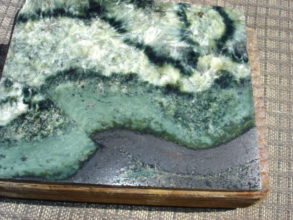
Ghost Nephrite from Nevada. Top half is Chatoyant Actinolite, middle is Nephrite, and the bottom is Magnetite.
Some white, green and slightly red nephrite of unknown origins. Probably from California.
Dendritic nephrite mostly likely from Wyoming similar to another from Wyoming owned by Dan Beck.
Jadeite from Leech Mountain Claim California.
Rare Wyoming nephrite with tourmaline sprays.



